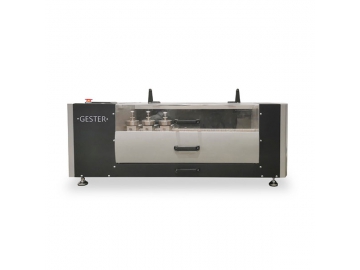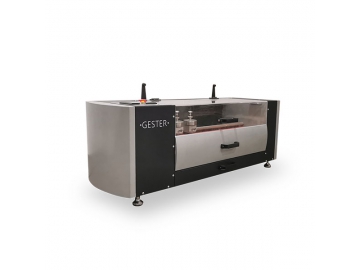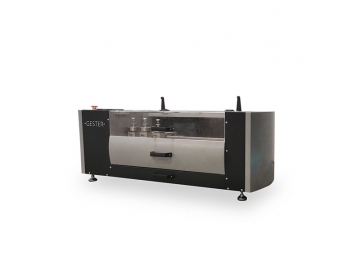DIN Abrasion Tester GT-KB03B
Application
DIN abrasion tester is used to determine wear performance tests of materials like elastic material, rubber, tires, conveyor belts, and shoe soles.
Feature
1.Paint baking process used on machine body, allowing for easy maintenance
2.Color touch-screen control, digital counting, automatically stop after finishing test
3.Equipped with vacuum suction port to automatically clean dust during test
| Model | | |
| Test positions | 1 | 3 |
| Control mode | Touch screen controller | |
| Diameter of wear wheel | 150mm | |
| Specimen dimension | ø16.2 mm x thickness 6-10 mm | |
| Specimen moving speed | 4.2 mm/r | |
| Weights | Holder 2.5N, can be used arbitrarily with optional accessory 2.5N, 5N (each for one) | |
| Wear wheel speed | 40±1rpm | |
| Inclination angle | 3°, support shaft of test piece becomes vertical angle with roller | |
| Grit size of sandpaper | #60 | |
| Roller length | 460mm | |
| Wear stroke | 40m | |
| Power supply | 1∮AC 220V 50/60HZ 3A | |
DIN-53516, JIS-K6369, JIS K6264-2,GB/T 20991 section 8.3,GB/T 20265, GB20266-2006, GB/T 9867,EN ISO 20344-2020 section 8.4, AS/NZS 2210.2 section 8.3, ISO 4649, BS903-A9 Method A, ASTM D5963, ISO20871, QB/T2884, SATRA TM 193, SATRA TM174, EN 12770
Accessories| Standard accessories | 1set | 2.5N weights |
| 1set | 5N weights | |
| 1pc | P60# standard abrasive paper | |
| 1pc | Standard cutting die | |
| 1pc | Metal blob(grinding head) | |
| 1pc | 2mm gauge | |
| 1pc | Power line | |
| Optional accessories | Optional | GT-G203H electronic balance (210g, accuracy) 1mg) |
| Optional | Standard rubber |
Under certain touching pressure and contact area, the sample forms a certain angle with the sandpaper and determines its abrasion performance caused by a certain level of sandpaper. Pack sandpaper outside the roller surface. The sample is pressed against the roller with sandpaper, making the sample lateral moving along the roller. Abrasion is caused under the other side of cylindrical specimens measuring the mass loss of sample value and count the wear amount by sample density.




